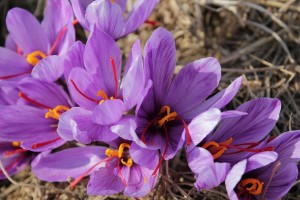Iranian Souvenirs

Iran is a great place to buy souvenirs and you will find it hard not to indulge yourself. In fact due to its very old civilization, rich cultures and also geographical location, has an important role in the world arts and crafts.
Mass production is not common, prices are low and the quality is generally high, even at the budget end of market. Naturally, the bazaar is the best place to start looking, although much of what is on sale in places like Kerman, kashan and Hamadan is more likely to suite local tastes.
Conversely, in places like Isfahan and Shiraz where foreign tourists are more common, the goods may be more inviting. if you are not keen on haggling and don’t have much time to look around, the government – run Iran handicrafts organizations has fixed – price shops in most provincial capitals.
Various places in Iran specialize in specific products. Often, knowing the best place to buy something is as important as getting a good price.
Iranian souvenir is varied in many different types from food and drink to clothing or handicraft. Here is a list of most important ones:
Persian Khatam –Inlaidwork
Khatam or Persian version of marquetry, is the art of decorating the surface of wood with delicate pieces of metal, bone and wood precisely cut in geometrical figures and shapes.
It is one of the finest handicraft artworks of Iran. The oldest specimen obtained so far belongs to the Safavids period. Iran of today is the most important center of the inlaid work in the world .The materials used in the construction of inlaid articles can be in gold, silver, brass, aluminum and twisted wire. Artworks with smaller inlaid pieces are generally more highly valued.
Khatam is made in different sides five, six, eight, and ten sides. At present, the six sided Khatam is the most prevalent whose materials are cut and wrapped or pasted in equilateral triangle form with string or glue.
Designing of inlaid articles is a highly elaborate process. In each cubic centimeter of inlaid work, up to approximately 250 pieces of metal, bone, ivory and wood are laid side by side.
Inlaid articles in the Safavid era took on a special significance as artists created their precious artworks. These works include; doors and windows, mirror frames, Quran boxes, inlaid boxes, pen and penholders, lanterns and inlaid ornamented shrines.
Inlaid work being of the fine arts has a deep history. Like other arts and handicrafts, this art is a beautiful and valuable pattern of Iranian taste and intelligence.
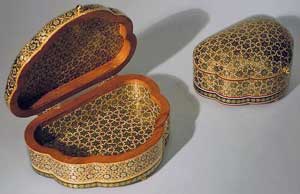
Persian Silverwork
The silverworks discovered in Sialk mounds belonging to the fourth millennium BC indicates that the people of this area of Iran had been familiar with silver and making handicrafts with. The engraved designs on silver left by the artists of the past are indicative of national morale and the phenomena of their time. It is believed that silver dishes and trinkets would be exported to pc other countries in Sassanid and Seljuk periods. Undoubtedly, the silver workers of the Sassanid time have applied the three methods below in their works:
1-Makingsilverworks with hammer on silver sheets
2- Using die casting for silver objects
3-Making underlain dishes with silver sheets
Silver has always been taken into special consideration as one of the valuable metals available in the nature. It is a shining, illuminating and publishable metal being able to reflect light better than other materials, therefore, it has been applied in mirror making as its primary application; in other words, mirror is a thin layer of silver kept by a glass sheet.

Mina & Minakari – Painting on Metal: Enamelin
Minakari or Enamelling is the art of painting, colouring and ornamenting the surface of metals by fusing over it brilliant colours that are decorated in an intricate design. The Iranian invented the art of enamel or minawork metalcraft and Mughuls spreaded it to India and other countries. Gold has been used traditionally for minakari jewellery as it holds the enamel better, lasts longer and its lustre brings out the colours of the enamels. Silver, a later introduction, is used for artifacts like boxes, bowls, spoons, and art pieces while Copper which is used for handicraft products were introduced only after the Gold Control Act, which compelled the minakars to look for a material other than gold, was enforced around the world.
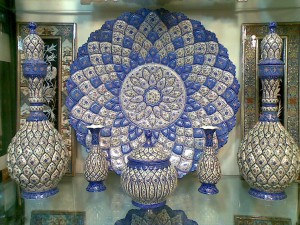
Persian Carpet
The best known Iranian cultural export, the Persian carpet, is far more than just a floor covering to an Iranian. A Persian carpet is a display of wealth, an investment and integral part of religious and cultural festivals and used in everyday life, e.g., as a prayer mat.
Iran is the World’s leading carpet producer. Persian carpets are in great demand everywhere across the world in spite of the existing challenges in the global carpet market.
The earliest known Persian carpets, which probably date back to the 5th century, was discovered in a remote parts of Siberia, suggesting that carpets were made in Persia more than 2500 years ago.
Historians know that by the 7th century AD, Persian carpets made of wool or silk had become famous in court circles throughout the region. Their quality and subtlety of design were renowned and carpets were exported to places as far away as china, although for many centuries they must have remained a great luxury in their country of production, with the finest pieces reserved for royalty.
The early patterns were usually symmetrical with geometric and floral motifs designed to evoke the beauty of classic Persian garden. Towards the end of the pre-Islamic period, stylised animal and human figures become more popular.
After the Arab conquest, quranic verses were incorporated into some carpet designs, and prayer mats began to be produced on a grand scale; secular carpets also became a major industry and were highly prized in European courts .very few examples remain form before the 16th century, however, and little is known of early methods of weaving and knotting ,or of differences in regional styles. The classification of existing pieces is often arbitrary.
Five basic factors namely pile material and construction, design and color composition, border design and foundation threads determine the quality of a carpet while characteristics such as the size of the carpet and its knot density are also among the factors that determine a carpet’s value.
Persian carpets come in three main sizes:
The main farsh carpet is up to 3m long and up to 2.5m wide; the kellegi carpet is about 3.5 long and nearly 2m wide; and the kenareh carpet is up to 3m long and 1m wide.
The best are made from wool from sheep, goats and occasionally camels), although its quality varies form region to region .cotton is cheaper and easier to use than wool and silk is used mainly for decorative rugs as it is not practical for everyday use.
The best Persian carpets which manifest the highly developed artistic craftsmanship of the Iranian people arc usually woven in Tabriz ,Kashan ,Qom ,Isfahan ,Mashad, Kerman ,Naeen ,Josheghan, Hamadan and Turkmen Sahara: while the art of carpet weaving is also widely appreciated and practiced in almost every other part of the count.

Persian Kilim
Another important and most valuable handicraft, which has a worldwide reputation, is Gelims, a double sided flat-woven mat without knots. These rugs are thinner and softer than knotted carpets and rarely used as floor coverings. They are popular as prayer mats and wall hangings.
Many people especially women are involved in this industry, in large and small carpet workshops, scattered throughout Iran. Nomadic women weave a simple kind of carpet in their leisure time called Jajim (coarse). Jajim is softer and lighter than Kilim. In addition to these, other hand-woven products like cashmere, shawls, and different cloth are produced in Iran for different uses.
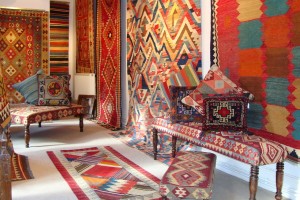
Persian Miniature
A miniature is a richly detailed miniature painting which depicts religious or mythological themes from Iran. These delicate, lush paintings are typically visually stunning, with a level of detail which can only be achieved with a very fine hand and an extremely small brush.
The art of miniature painting in Persia flourished from the 13th through the 16th centuries, and continues to this day. It had a second flowering during the period when the Safavid capital was at Qazvin. Later, artists from eastern Iran, who had studied under the great muhhammedi in Heart also started to influence this form of art.
Its themes are mostly related to Persian mythology and poetry. Favorite subjects include courting couples in traditional dress, polo matches and hunting scenes. Many of these paintings are quite small, but they feature rich, complex scenes which can occupy a viewer for hours. It also merit undivided attention; the longer one looks at a Persian miniature, the more details and themes emerge.
The perspective in miniature also tends to be very intriguing, with elements overlaid on each other in ways which sometimes feel awkward to people who are accustomed to the look and feel of Western art.
Kamal-o-din behzad, Reza Abbasi, Hossein behzad and Mahmood farschian are of the important Persian miniaturists .Some of the best modern miniatures comes from Esfahan.
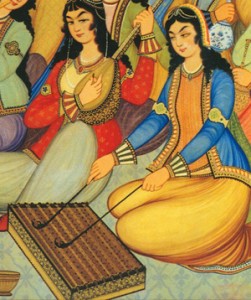
Iran Tile working
Although the art of enameled brick making dates back to 3500 years before, the works remaining since the Achaemenid time made 500 Be and the enameled bricks with particular designs narrate the Iranian science on this art. Long after, in particular, during the Islamic periods, this art was used through new applications along with new designs and various methods as golden colored and seven colored inlaid works (Mo-arragh as it is called in Persian).
Everywhere you go in Iran you will see glistening, multi-colored tiles, coating the walls, domes and minarets of mosques, and decorating the edges of every kind of building from schools to government offices. The tiled domes of Iranian mosques, reminiscent of Faberge eggs in the vividness of their coloring, are likely to remain one of your abiding memories of Iran.
The art of Persian tile production dates back to the Elimate period. However, the real glory period for the tile-makers came during the Safavid period and especially in the 16th century.
Tiles from the period come in two main forms. The very best are really mosaics-look closely at the walls and you will see that the patterns have been picked out in tiny pieces of the tile rather than created in one piece. Less fine are the haft rengi (seven colored) tiles, which are normal square tiles with a painted surface. Since these were not as hard-wearing as mosaic tiles, haft rengi tiles normally appear only on the inside of the buildings.
At present, Isfahan is a city where the most beautiful of seven colored, enameled and Mo-arragh glazing tiles are made being the decorative of architectural part of the Islamic countries.

Iran Ceramics & Pottery
Ceramic Industry is one of the oldest industries in the world. The first ever-excavated ceramic objects belonging to 10 to 12 thousand years ago were explored in Zagros mountain range in Iran that indicate a long and shining history in it. Archeological studies in Iran have shown that pottery in Iran has a history as old as 8,000 years.
One of the most important characteristics of the pottery and ceramics in different regions of Iran is “the expressive and beautiful decorations” on them. These decorations in different parts of Iran are completely compatible with the people’s belief, culture and climate of those areas.
Exceptional and marvelous items were created in that era. Decorating historical monuments and buildings inclusive of mosques in Isfahan and other Iranian towns.
The color and quality of Iranian tiles and ceramics are so unique that they have resisted hard climatic and erosive conditions of Iran for centuries. “Sultanabad” and “Lajvardina” are two types of pottery.
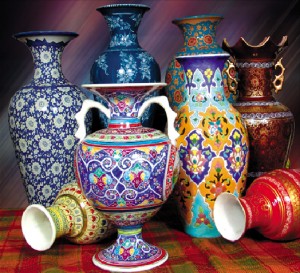
Iran Pistachio
Iran’s pistachio as an exclusively Iranian fruit is one of the best pistachios in the world. Even today, with the introduction of the product from some other countries, Iranian pistachio still ranks first in international market thanks to its rich taste, unique way of processing, nutritive attributes and the eye catching appearance that has made it famous worldwide as smiling pistachio.
The pistachio tree is an old tree with a great antiquity. It is grown in most parts of Iran particularly in Kerman province (Rafsanjan, Sirjan, Zarand, Ravar, and Shahr Babak) ; They produce more than 90 percent of the country’s pistachio while the rest is produced in Damghan, Ardakan, Yazd, Saveh, Ghazvin, and some other cities in Khorassan and Isfahan province.
There are about 40 million pistachio trees in Iran with over 80 thousand hectares of land under cultivation. Now Iran’s pistachio is one of the best pistachios in the world.
In late march the tree of pistachio begin to bloom and usually in Septembers the nuts are ready to be harvested.

Iran Caviar
The Iranian caviar as the best caviar in the world is a very lucrative export good of Iran, with roughly half being collected from sturgeons near Bandar –e torkaman.
Its tiny grey pearls make the ever body’s eyes sparkling. One tastes it “like a sea candy, filled with iodine and powdered with mystery” (Robert Courteline).
No country can compete with Iran in processing and producing caviar because Iran’s caviar is well known as the best of its kind across the world. Many foreigners regard caviar as one of the few characteristically Iranian goods; view the offering of caviar as a sign of generous hospitality and special treatment.
In one word, Festivity can start with it!

Iran Saffron
The word saffron derives from the Arab word zafaran, meaning yellow, and it was mentioned as far back as 1500 B.C. in many classical writings, as well as in the Bible. Saffron is one of the few things that truly are worth its weight in gold. Its botanical name is crocus sativus and been introduced as the most expensive spice in the world.
Saffron has an aroma and flavor which cannot be ignored, also it has a chemical make-up which, when understood, adds not only pungent and aromatic flavor to foods, but also a beautiful golden color.
Extracts from the plant can also help with digestive problems and nervous disorders.
Saffron seeds are planted in may or August, then irrigated with care, before the bright pink or violet flowers bloom for about three weeks from mid-october.the stigmas are separated and left to dry in sheds, or hung from the roof in special containers, and then crushed into powder.
It takes a staggering 2000 to 3000 flowers to make about 15g of saffron powder.
